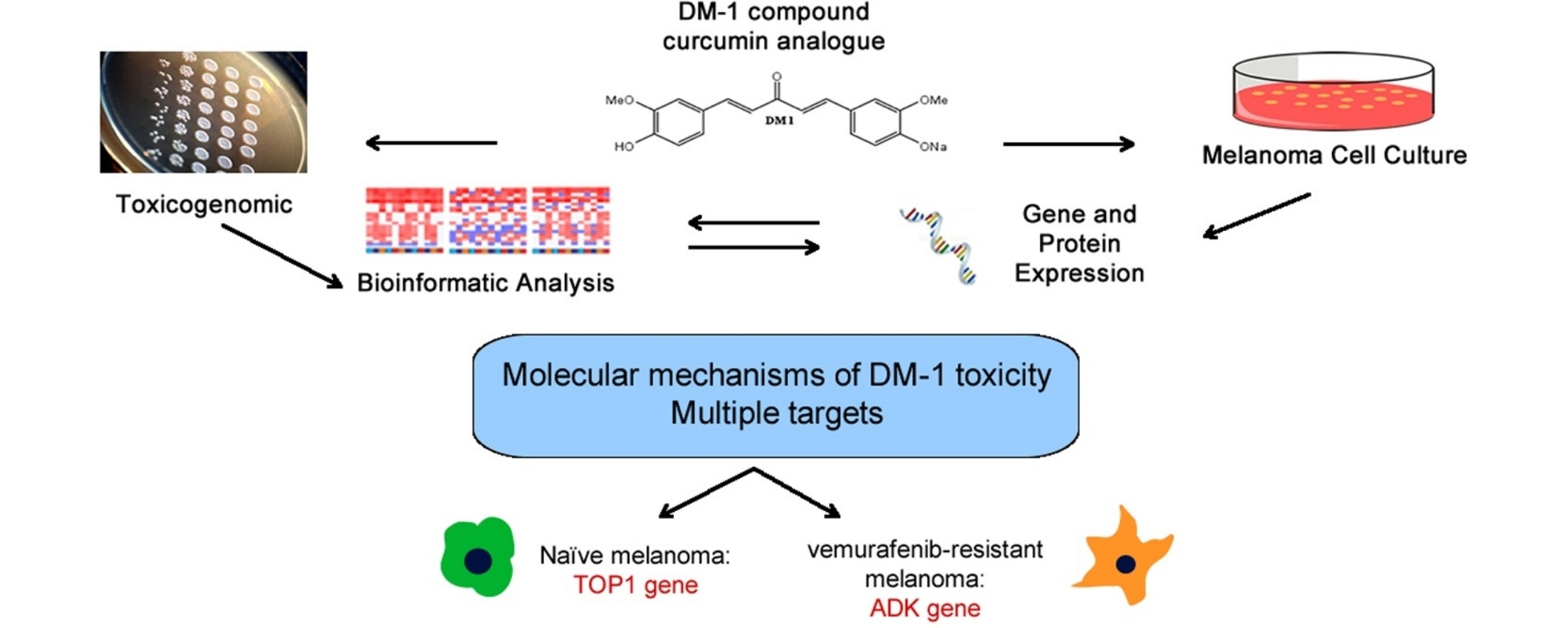Toxicogenomic and bioinformatics platforms to identify key molecular mechanisms of a curcumin-analogue DM-1 toxicity in melanoma cells.
Melanoma is a highly invasive and metastatic cancer with high mortality rates and chemoresistance. Around 50% of melanomas are driven by activating mutations in BRAF that has led to the development of potent anti-BRAF inhibitors. However resistance to anti-BRAF therapy usually develops within a few months and consequently there is a need to identify alternative therapies that will bypass BRAF inhibitor resistance. The curcumin analogue DM-1 (sodium 4-[5-(4-hydroxy-3-methoxy-phenyl)-3-oxo-penta-1,4-dienyl]-2-methoxy-phenolate) has substantial anti-tumor activity in melanoma, but its mechanism of action remains unclear. Here we use a synthetic lethal genetic screen in Saccharomyces cerevisiae to identify 211 genes implicated in sensitivity to DM-1 toxicity. From these 211 genes, 74 had close human orthologues implicated in oxidative phosphorylation, insulin signaling and iron and RNA metabolism. Further analysis identified 7 target genes (ADK, ATP6V0B, PEMT, TOP1, ZFP36, ZFP36L1, ZFP36L2) with differential expression during melanoma progression implicated in regulation of tumor progression, cell differentiation, and epithelial-mesenchymal transition. Of these TOP1 and ADK were regulated by DM-1 in treatment-naïve and vemurafenib-resistant melanoma cells respectively. These data reveal that the anticancer effect of curcumin analogues is likely to be mediated via multiple targets and identify several genes that represent candidates for combinatorial targeting in melanoma.
Authors
Érica Aparecida de Oliveira; Diogenes Saulo de Lima; Lucas Esteves Cardozo; Garcia Ferreira de Souza; Nayane de Souza; Debora Kristina Alves-Fernandes; Fernanda Faião-Flores; José Agustín Pablo Quincoces; Silvia Berlanga de Moraes Barros; Helder I Nakaya; Gisele Monteiro; Silvya Stuchi Maria-Engler
External link
Publication Year
Publication Journal
Associeted Project
Drug repositioning
Lista de serviços
-
Genomic analyses reveal broad impact of miR-137 on genes associated with malignant transformation and neuronal differentiation in glioblastoma cells.Genomic analyses reveal broad impact of miR-137 on genes associated with malignant transformation and neuronal differentiation in glioblastoma cells.
-
RNA-Binding Protein Musashi1 Is a Central Regulator of Adhesion Pathways in Glioblastoma.RNA-Binding Protein Musashi1 Is a Central Regulator of Adhesion Pathways in Glioblastoma.
-
MicroRNA Transcriptome Profiling in Heart of Trypanosoma cruzi-Infected Mice: Parasitological and Cardiological Outcomes.MicroRNA Transcriptome Profiling in Heart of Trypanosoma cruzi-Infected Mice: Parasitological and Cardiological Outcomes.
-
Genome mapping and expression analyses of human intronic noncoding RNAs reveal tissue-specific patterns and enrichment in genes related to regulation of transcription.Genome mapping and expression analyses of human intronic noncoding RNAs reveal tissue-specific patterns and enrichment in genes related to regulation of transcription.
-
Antimicrobial peptide LL-37 participates in the transcriptional regulation of melanoma cells.Antimicrobial peptide LL-37 participates in the transcriptional regulation of melanoma cells.
-
Down-regulation of 14q32-encoded miRNAs and tumor suppressor role for miR-654-3p in papillary thyroid cancer.Down-regulation of 14q32-encoded miRNAs and tumor suppressor role for miR-654-3p in papillary thyroid cancer.
-
Integration of miRNA and gene expression profiles suggest a role for miRNAs in the pathobiological processes of acute Trypanosoma cruzi infection.Integration of miRNA and gene expression profiles suggest a role for miRNAs in the pathobiological processes of acute Trypanosoma cruzi infection.
-
Integrative Biology Approaches Applied to Human DiseasesIntegrative Biology Approaches Applied to Human Diseases
-
Proteomics reveals disturbances in the immune response and energy metabolism of monocytes from patients with septic shock.Proteomics reveals disturbances in the immune response and energy metabolism of monocytes from patients with septic shock.
-
Genomics, epigenomics and pharmacogenomics of Familial Hypercholesterolemia (FHBGEP): A study protocol.Genomics, epigenomics and pharmacogenomics of Familial Hypercholesterolemia (FHBGEP): A study protocol.
-
Melatonin-Index as a biomarker for predicting the distribution of presymptomatic and asymptomatic SARS-CoV-2 carriersMelatonin-Index as a biomarker for predicting the distribution of presymptomatic and asymptomatic SARS-CoV-2 carriers
-
Profiling plasma-extracellular vesicle proteins and microRNAs in diabetes onset in middle-aged male participants in the ELSA-Brasil study.Profiling plasma-extracellular vesicle proteins and microRNAs in diabetes onset in middle-aged male participants in the ELSA-Brasil study.
-
Big Data and machine learning in cancer theranosticsBig Data and machine learning in cancer theranostics
-
Genomic positional conservation identifies topological anchor point RNAs linked to developmental loci.Genomic positional conservation identifies topological anchor point RNAs linked to developmental loci.
-
Integrative systems immunology uncovers molecular networks of the cell cycle that stratify COVID-19 severityIntegrative systems immunology uncovers molecular networks of the cell cycle that stratify COVID-19 severity

